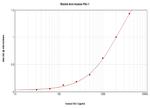Search Thermo Fisher Scientific
图: 1 / 3
PAI1 Antibody (500-P260-1MG) in WB



产品信息
500-P260-1MG
种属反应
已发表种属
宿主/亚型
分类
类型
抗原
偶联物
形式
浓度
纯化类型
保存液
内含物
保存条件
运输条件
RRID
产品详细信息
AA Sequence of recombinant protein: VHHPPSYVAH LASDFGVRVF QQVAQASKDR NVVFSPYGVA SVLAMLQLTT GGETQQQIQA AMGFKIDDKG MAPALRHLYK ELMGPWNKDE ISTTDAIFVQ RDLKLVQGFM PHFFRLFRST VKQVDFSEVE RARFIINDWV KTHTKGMISN LLGKGAVDQL TRLVLVNALY FNGQWKTPFP DSSTHRRLFH KSDGSTVSVP MMAQTNKFNY TEFTTPDGHY YDILELPYHG DTLSMFIAAP YEKEVPLSAL TNILSAQLIS HWKGNMTRLP RLLVLPKFSL ETEVDLRKPL ENLGMTDMFR QFQADFTSLS DQEPLHVAQA LQKVKIEVNE SGTVASSSTA VIVSARMAPE EIIMDRPFLF VVRHNPTGTV LFMGQVMEP.
Preparation: Produced from sera of rabbits immunized with highly pure Recombinant Human PAI-1. Anti-Human PAI-1-specific antibody was purified by affinity chromatography employing an immobilized Human PAI-1 matrix.
Sandwich ELISA: To detect Human PAI-1 by sandwich ELISA (using 100 µL/well antibody solution) a concentration of 0.5-2.0 µg/mL of this antibody is required. This antigen affinity purified antibody, in conjunction with PeproTech Biotinylated Anti-Human PAI-1 (500-P260Bt) as a detection antibody, allows the detection of at least 0.2-0.4 ng/well of Recombinant Human PAI-1.
Western Blot: To detect Human PAI-1 by Western Blot analysis this antibody can be used at a concentration of 0.1-0.2 µg/mL. Used in conjunction with compatible secondary reagents the detection limit for Recombinant Human PAI-1 is 1.5-3.0 ng/lane, under either reducing or non-reducing conditions.
靶标信息
PAI1 (plasminogen activator inhibitor 1) belongs to serine protease inhibitor superfamily, and is the principal inhibitor of tissue-type and urokinase-type plasminogen activators (tPA and uPA). Platelets are the main source of the circulating PAI11, but it is synthesized and secreted by many tissue and cell types, including fibroblasts, smooth muscle cells, endothelial cells, hepatocytes, and inflammatory cells. Expression of PAI11 can be regulated at the transcriptional level by many factors including growth factors, cytokines, hormones, inflammatory factors, glucose or lipid metabolites, vascular tone regulating factors, chemicals, and other environmental or physical factors. PAI1 is present at increased levels in various disease states, and has been linked to an increased occurrence of thrombosis in obesity, thrombophilia and the metabolic syndrome. Defects in PAI-1 are characterized by abnormal bleeding. PAI1 mediates inhibition of fibrinolysis by inhibiting the activity of plasminogen activator, and may promote neuronal survival. Other defects in PAI1 are the cause of plasminogen activator inhibitor-1 deficiency (PAI-1 deficiency). Alternatively spliced transcript variants encoding different isoforms of PAI1 have been found.
仅用于科研。不用于诊断过程。未经明确授权不得转售。
生物信息学
蛋白别名: Endothelial plasminogen activator inhibitor; PAI; plas; Plasminogen activator inhibitor 1; serine (or cysteine) proteinase inhibitor, clade E (nexin, plasminogen activator inhibitor type 1), member 1; Serpin E1; serpin peptidase inhibitor, clade E (nexin, plasminogen activator inhibitor type 1), member 1; SERPINE-1
基因别名: PAI; PAI-1; PAI1; PLANH1; SERPINE1
UniProt ID: (Human) P05121
Entrez Gene ID: (Human) 5054



